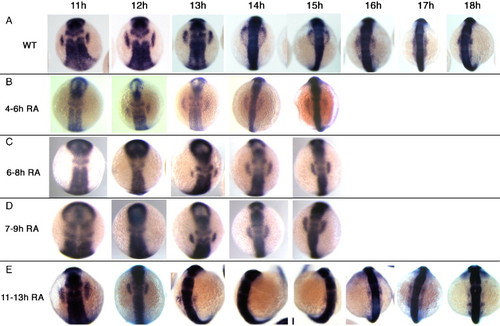Fig. 4
- ID
- ZDB-FIG-111025-46
- Publication
- Sun et al., 2007 - Epibranchial and otic placodes are induced by a common Fgf signal, but their subsequent development is independent
- Other Figures
- All Figure Page
- Back to All Figure Page
|
Fgf signaling is continuously required for maintenance of placodal sox3 expression. Embryos were treated with SU5402 to inhibit Fgf signaling for various periods of embryonic development, fixed at a range of time points and sox3 expression analysed by in situ hybridization. (A) sox3 expression in DMSO treated controls. (B) Inhibition of Fgf signaling from 4–6 hpf. Placodal expression of sox3 is delayed, only appearing at 12 hpf after which time expression is similar to wild type. Inhibition of Fgf signaling from 6–8 hpf (C) or 7–9 hpf (D) further delayed placodal expression of sox3, appearing at 13 hpf after which time expression is similar to wild type. (E) Inhibition of Fgf signaling after placodal sox3 expression was initiated, from 11–13 hpf. Placodal expression of sox3 is lost between 14 and 15 hpf, after which time it reappears in a pattern similar to wild-type. |
| Gene: | |
|---|---|
| Fish: | |
| Condition: | |
| Anatomical Terms: | |
| Stage Range: | 1-4 somites to 14-19 somites |
| Fish: | |
|---|---|
| Condition: | |
| Observed In: | |
| Stage Range: | 1-4 somites to 10-13 somites |
Reprinted from Developmental Biology, 303(2), Sun, S.K., Dee, C.T., Tripathi, V.B., Rengifo, A., Hirst, C.S., and Scotting, P.J., Epibranchial and otic placodes are induced by a common Fgf signal, but their subsequent development is independent, 675-686, Copyright (2007) with permission from Elsevier. Full text @ Dev. Biol.

